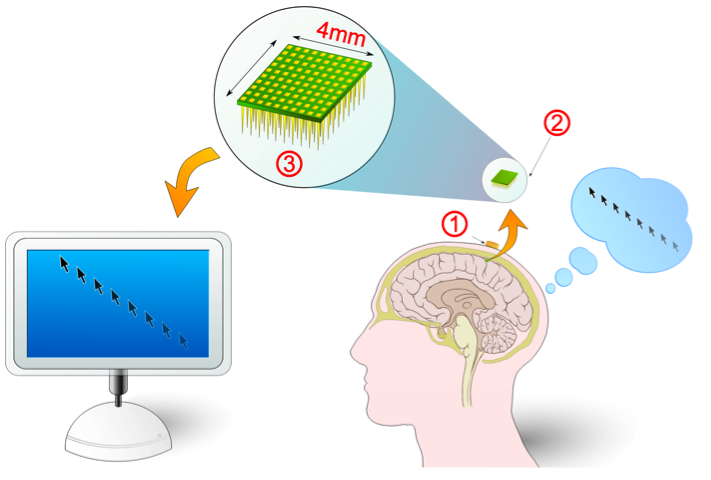Neuralink
May 24, 2017
Neuralink, a new company started by Elon Musk (founder of SpaceX, Tesla Motors, and SolarCity), has the goal of interfacing the human brain with machines. Where are we headed?
Why Create Neuralink?
Elon Musk has described some of his ideas publicly. The premise for his latest company, Neuralink, is Musk’s concern that if artificial intelligence (AI) continues to grow at any rate, it will surpass human intelligence by a large amount. He is taking measures to try to increase the probability that the outcome of this would be good rather than bad, but worries that even in a benign scenario humans could end up as the equivalent of pets to an AI, rather than controlling it.
Musk believes that one solution to this could involve humans interfacing with machines by adding a digital layer to our brains above the cerebral cortex. He feels that the fundamental limitation of the human brain is the rate at which we input and output information, primarily that our output rate is too slow. By streamlining the transmission of information from brain to computer, Musk believes humans will be able to increase their input/output capabilities, and hopefully avoid being left in the dust by artificial intelligence. The digital layer would not be surgically implanted, but might be injected into the blood stream, and layer itself atop the cortex.
In a 2016 Code Conference interview, Musk describes his reasons behind Neuralink, and how he envisions the creation of the digital interface:
Neuralink's New Homepage States:
“Neuralink develops high bandwidth and safe brain-machine interfaces.”2 Let’s look at this statement: The high bandwidth refers to the slow input/output rate of humans. The brain interfaces have been around for a while, but they are ever improving.
Where Organisms and Machines Meet
There is a wide range of devices involved in human-machine interfacing. Probably the best known innovator is Kevin Warwick.3 He has made some amazing progress on interfacing himself with machines. Warwick had wonderful success controlling a robotic arm stationed in England while he was in NY, by transmitting his brain waves across the Atlantic Ocean via the internet—see our page The Cyborg Scientist for more on Warwick.
Current electronic brain interfaces help prevent seizures in epileptic patients, control tremors in Parkinson patients, improve hearing, improve visual impairment, control prosthetics, or utilize a computer, for example, allowing paraplegics and others to communicate. The basic set-up is shown in the graphic below. Most of the hardware described above is surgically implanted, and often the hardware is eventually rejected or causes damage to nearby tissue, but overall the benefits of these interfaces have outweighed these side-effects.

A brain-computer interface. The person thinks about moving the mouse pointer. The change in electrical activity of the neurons is translated to an electrical impulse that controls the mouse pointer on the computer screen.
Image Credit: Wiki user Balougador (CC BY-SA 3.0)
What Musk hopes to do is interface directly with the cerebral cortex using injectable “hardware” that is not rigid. The cerebral cortex is the outermost layer of the brain, shown as darker regions in the image below. The cerebral cortex is between 2 to 4 millimeters thick, and covers a surface area of about a quarter of a square meter, providing a large area for a potential interface to be set up.

The darker regions on the outer layer are the cerebral cortex, which has a total surface area of about a quarter of a square meter.
Image Credit: Brainmaps.org, via Wikimedia Commons (CC BY 3.0)
Musk discussed injecting the interface into the bloodstream. There are three main arteries that go to three main regions of the cerebral cortex, and there has been successful research in injecting implants.
The two major concerns with any implant are the body rejecting the object and the object damaging surrounding tissue. Most brain implants are rigid and tend to cause damage to the surrounding tissue. In 2016 one scientific group reported5 a way to create a flexible mesh of nanowires whose stiffness is similar to dense neural tissue. The mesh is made of parallel polymer-coated silicon wires, with another set of plain polymer wires perpendicular to these. The mesh curls up and can be injected with a syringe in the region of the cerebral cortex. Once in the vicinity of its destination, the mesh unfurls and lays atop the cortex.
The mesh forms an array of field effect transistors, which detect small changes in electric fields. When the surrounding electric field changes, a current begins to flow from one region of the mesh to another. These transistors are smaller than a neuron, meaning the activity of individual neurons can be mapped. Also, since the mesh is directly in contact with the cerebral cortex, it is able to very accurately detect the firing of neurons deeper in the brain.
The scientists who helped develop the mesh4,5 were able to observe how a mouse’s brain changes as it grows older. This technology mapped the activity of individual neurons over 8 months of the lives of the mice in the study, without rejection by the mouse or damage to tissue.5
Detected electrical changes can be mapped to commands and used to control a prosthetic arm, or a computer. For example, imagine doing an internet search for information about neurons. The thought of the word “neurons” has a distinct electrical pattern, as does the more abstract thought of an internet search. These electrical patterns could be transmitted, via the electronic mesh layer, to a computer. Similarly, you might imagine the information being uploaded by the computer directly to the brain, stimulating the proper neurons involved in making sense of the information. This brings us to input/output and bandwidth.
Bandwidth
What exactly is bandwidth? It turns out there are multiple definitions, but in this situation, bandwidth is how fast information can be transmitted, or the bitrate. If you could simply think about doing an internet search on neurons rather than typing it in, it would already make a big difference in terms of time. That time saving could also go into the transfer rate from computer to our brain if the information could skip our eyes on the way to us.
Currently, the human brain outperforms all computers in its calculation time. For example, the fastest computer in the world, Tianhe-2, has a processing speed of 54.902 petaflops—about 55 quadrillion calculations per second6. The human brain is postulated to have 1 exaflop of capacity, or a qunitillion (a thousand quadrillion) calculations per second. Calculations per second is not the issue, yet—the issue is inputting and outputting that information. Think about how fast you type, compared to how fast you create sentences in your head.
Current electronic brain interfaces can’t keep pace with a healthy human’s typing speed, but the technology is rapidly advancing, and already allows people with disabilities to navigate a computer using only their thoughts. One recent study involving brain interfaces focused on typing. In this study, the scientists were interested in a way to increase the output by modifying the digital interface. The subjects were rhesus macaques that used a visual keyboard to transcribe information. The initial interface they used had the monkeys control a cursor with their thoughts, hovering at a symbol on the keyboard to select it. The researchers modified the letter selection to one that utilized brain activity corresponding to thinking about “clicking" on the letter as they viewed it rather than hovering the cursor. This simple modification led to a modest increase in typing rate and bit rate.6 This study supports the idea that output rates might be increased by improving the digital interface. A short video about their research can be viewed at the link to their paper.6
As the technology improves, it may one day become possible to move beyond this simple interface and output our sentences just by thinking of them and having a digital interface transmitting those thoughts to a computer.
Manning and Controlling
The interface that allows animals to control a computer with their minds is a one-way device that responds to the input of neural activity, but a different design could allow commands to flow the other direction. According to one Nature article, a group of scientists in Taiwan have mapped out part of the fruit fly’s brain,8 allowing the researchers to control the insect’s head movement or wing movement by using a computer to stimulate a specific set of neural pathways. It took the scientists a full decade to map out 60,000 of the fruit fly’s neurons, less than half its brain, each neuron taking over a gigabyte of data to represent. One neuroscientist estimates that the using the same imaging protocol, it would take over 17 million years to completely map out a human brain.8 Mapping of the cerebral cortex has already been done, although at a low resolution. High-res mapping of mammalian brains is estimated to take terabytes (trillions of bytes) of data.
Dr. Ed Boyden’s team at MIT9 has also made significant progress in recording neural activity. For more information on initial research involving mapping and controlling the brain, see our article on optogenetics.
Future Research and Concerns
Elon Musk has a knack for selecting human problems that he can find innovative solutions to: everything from paypal, very drivable electric cars, reusable rockets, and attractive solar roof tiles, to hyperloops, underground transport systems, artificial intelligence, and increasing human capacity via a digital interface. In video of Musk’s discussions he frequently mentions improving the chances of good outcomes for the human race.
So research continues on improving artificial intelligence, and making sure it is open access, because Musk believes that power in the hands of many makes a democracy, while in the hands of few makes a system of despotism. And interfacing the brain with technology should keep humans on equal footing with artificial intelligence and those that might control it.
However, concerns of control arise. Hopefully systems will be put in place to take into consideration: Who drives what? Will humans drive machines? Could machines drive humans, or some humans control others through their digital devices? Creating hack-proof hardware as part of the direct human interface would be essential, such as a fundamental boot system that cannot be written over, and can reboot internal digital systems that may become compromised. Otherwise, we may see a day where humans or machines are making other humans turn in circles, flap their arms, or shake their heads, as we have done with fruit flies,8 mice,10 and cockroaches.11
References and Resources
1. Strickland, E., 5 Neuroscience Experts Weigh in on Elon Musk's Mysterious "Neural Lace" Company,
IEEE Spectrum, 12 April 2017
2. Neuralink
3. Doss, H., The Cyborg Scientist, APS Physics Central, Physics in Action,
4. Savage, N., Injectable Nanowires Monitor Mouse Brains for Months, IEEE Spectrum, 29 Aug 2016
5. Fu, T-M., et al., Stable long-term chronic brain mapping at the single neuron level, Nat. Meth (13) 10, (2016)
6. Nuyujukian, P., et al., A nonhuman primate brain-computer typing interface, IEEE Proceedings, 105, 1 (2016)
7. Staughton, J., The human brain vs. supercomputers, which one wins?, Science ABC, (2017)
8. Landhuis, E., Neuroscience: big brain, big science, Nature, 541 7638 (2017)
9. Rodriques, S.G., et al., Multiplexed neural recording along a single optical fiber via optical reflectometry, J. Biomed. Opt. 21 (5) (2016)
10. Doss, H., Mind over matter, light over mind, Physics Central, Physics in Action,
11. Schupak, A, How to build your own cockroach cyborg: A mind controlled insect that scurries and stops on command, Pop. Sci, 6 December 2012
—H.M. Doss














